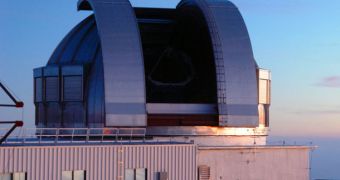University of Hertfordshire expert David Pinfield led an international team of astronomers that was recently able to discover an ultra-cool, brown dwarf-class star. The object, located relatively nearby, may help astronomers make better distinctions between brown dwarfs and gas giant-class planets.
Pinfield says that the object is called BD+01 2920B, and orbits a dwarf parent star called WISEP J142320.86+011638.1. The former is located around 2,600 astronomical units (AU) away from the star. An AU is the mean distance between the Sun and the Earth, around 93 million miles (157 million km).
The brown dwarf has two very important features. First, hydrogen and helium account for more than 99 percent of its chemical composition. Second, its surface temperature does not exceed 400 degrees Celsius (752ºF), making it an ultra-cool star.
By definition, the boundary between brown dwarfs and Jupiter-class gas giants is not very clear. Objects in the former category are also referred to as failed stars, because they were formed from molecular hydrogen gas clouds that were not sufficiently large to ignite properly.
The new observations, conducted using the NASA Wide-field Infrared Explorer (WISE) satellite, the UK Infrared Telescope (UKIRT), in Hawaii and the Visible and Infrared Survey Telescope for Astronomy (VISTA), in Chile, revealed the brown dwarf to be 35 times more massive than Jupiter.
One of the most important factors separating brown dwarfs from gas giants is their inherent chemistry. While the failed stars tend to have an atmospheric chemistry similar to that of their parent stars, gas giants tend to exhibit a more diverse chemical environment.
In the case of Jupiter, for example, the NASA Galileo spacecraft discovered a concentration of heavy chemical elements called metals, about three times higher than that on the Sun. A star's metallicity is an essential measure of whether or not that body will be able to form planets around itself.
“Surveys from telescopes like VISTA and UKIRT and orbiting observatories like WISE are giving us an unprecedented view of ‘ultra-cool’ bodies in our neighborhood,” Pinfield explains.
“By finding these rare objects in orbit around nearby stars, we get a handle on the bigger picture, that we live in a galaxy where both giant planets and brown dwarfs are commonplace,” the expert goes on to say.
Since gas giants and brown dwarfs share numerous characteristics, researchers plan to continue investigating the differences between these two classes of objects, Astrobiology Magazine reports.

 14 DAY TRIAL //
14 DAY TRIAL //